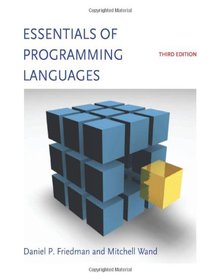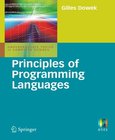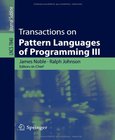Essentials of Programming Languages
3rd Edition

Book Details:
| Publisher: | The MIT Press |
| Series: | MIT Press , Essentials |
| Author: | Daniel P. Friedman |
| Edition: | 3 |
| ISBN-10: | 0262062798 |
| ISBN-13: | 9780262062794 |
| Pages: | 432 |
| Published: | Apr 18 2008 |
| Posted: | Nov 19 2014 |
| Language: | English |
| Book format: | |
| Book size: | 3.41 MB |
Book Description:
This book provides students with a deep, working understanding of the essential concepts of programming languages. Most of these essentials relate to the semantics, or meaning, of program elements, and the text uses interpreters (short programs that directly analyze an abstract representation of the program text) to express the semantics of many essential language elements in a way that is both clear and executable. The approach is both analytical and hands-on. The book provides views of programming languages using widely varying levels of abstraction, maintaining a clear connection between the high-level and low-level views. Exercises are a vital part of the text and are scattered throughout; the text explains the key concepts, and the exercises explore alternative designs and other issues. The complete Scheme code for all the interpreters and analyzers in the book can be found online through The MIT Press Web site. For this new edition, each chapter has been revised and many new exercises have been added. Significant additions have been made to the text, including completely new chapters on modules and continuation-passing style. Essentials of Programming Languages can be used for both graduate and undergraduate courses, and for continuing education courses for programmers.Daniel P. Friedman is Professor of Computer Science at Indiana University and is the author of many books published by The MIT Press, including The Little Schemer (fourth edition, 1995), The Seasoned Schemer (1995), A Little Java, A Few Patterns (1997), each of these coauthored with Matthias Felleisen, and The Reasoned Schemer (2005), coauthored with William E. Byrd and Oleg Kiselyov. Mitchell Wand is Professor of Computer Science at Northeastern University.
Download Link:
Related Books:
Principles of Programming Languages
Weve known about algorithms for millennia, but weve only been writing c- puter programs for a few decades. A big di?erence between the Euclidean or Eratosthenes age and ours is that since the middle of the twentieth century, we express the algorithms we conceive using formal languages: programming languages. Computer scientists are not the only ones who use formal languages. - tometrists, for example, prescribe eyeglasses using very technical expressions, ? ? such as OD: -1.25 (-0.50) 180 OS: -1.00 (-0.25) 180 , in which the parent- ses are essential. Many such formal languages have been created throughout history: musical notation, algebraic notation, etc. In particular, such languages have long been used to control machines, such as looms and cathe...
Transactions on Pattern Languages of Programming III
The Transactions on Pattern Languages of Programming subline aims to publish papers on patterns and pattern languages as applied to software design, development, and use, throughout all phases of the software life cycle, from requirements and design to implementation, maintenance and evolution. The primary focus of this LNCS Transactions subline is on patterns, pattern collections, and pattern languages themselves. The journal also includes reviews, survey articles, criticisms of patterns and pattern languages, as well as other research on patterns and pattern languages. This book, the third volume in the Transactions on Pattern Languages of Programming series, presents five papers that have been through a careful peer review process involving both p...
IEC 61131-3 Programming Industrial Automation Systems
Concepts and Programming Languages, Requirements for Programming Systems, Decision-Making Aids
2nd Edition
The rapid advances in performance and miniaturisation in microtechnology are constantly opening up new markets for the programmable logic controller (PLC). Specially designed controller hardware or PC-based controllers, extended by hardware and software with real-time capability, now control highly complex automation processes. This has been extended by the new subject of safe- related controllers, aimed at preventing injury by machines during the production process. The different types of PLC cover a wide task spectrum - ranging from small network node computers and distributed compact units right up to modular, fau- tolerant, high-performance PLCs. T...
2007 - 2021 © eBooks-IT.org



